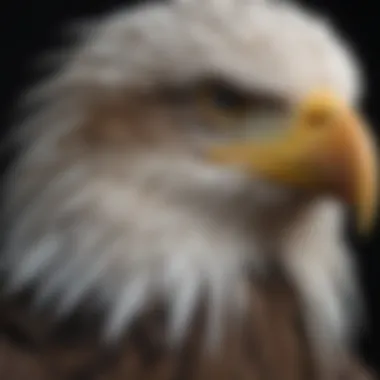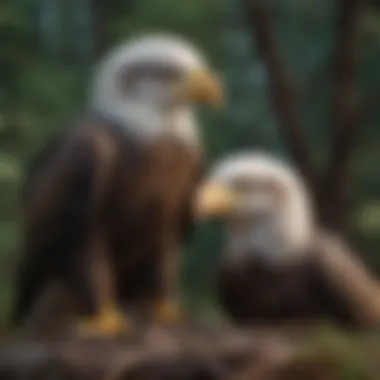Understanding the Unique Features of Female Bald Eagles


Nature Topic Overview
Bald eagles are among the most recognizable birds in the world. Known for their striking appearance and powerful presence, these majestic creatures are a subject of fascination. Understanding the physical characteristics of female bald eagles, particularly their head color, is essential for young readers. Female bald eagles are known for their distinctive white heads, but this characteristic does not emerge until they reach a certain age. This article will explore the development stages of bald eagles, the differences between genders, and the importance of these traits in their natural habitat.
Fun Facts and Trivia
Learning about bald eagles can be exciting! Here are some interesting facts:
- Bald eagles can live up to 20 years in the wild.
- A mature female bald eagle can weigh up to 14 kg (around 30 lbs), making them larger than males.
- Bald eagles have sharp talons that can exert pressure over 400 kg!
These facts not only show the physical capabilities of eagles but also their role in balance of the ecosystem. Visual elements like pictures or videos of bald eagles in their habitat can help children connect with these birds on a different level.
Wildlife Explorations
Eagles are fascinating, but they are part of a larger ecosystem. In the habitats where bald eagles live, there are other species that share their space. For example, ospreys, which are also birds of prey, hunt fish, just like eagles.
Other wildlife includes:
- Herons, known for their fishing skills.
- Salmon, a critical food source for eagles.
- Various types of trees that provide nesting sites.
By learning about these species, children can understand the interconnectedness of wildlife. Quizzes about eagle habitats or matching animals may help reinforce their knowledge.
Environmental Awareness
Bald eagles are symbols of strength and freedom, but their habitats face threats from pollution and habitat loss. Conservation is vital for their survival.
- Simple ways children can help include:
- Picking up trash in parks or nature reserves.
- Learning more about local wildlife and sharing this knowledge with friends.
- Participating in local conservation events.
Such small actions can make a significant impact, ensuring that future generations can enjoy these remarkable birds.
DIY Nature Activities
Hands-on activities can make learning about bald eagles fun! Here are some ideas:
- Eagle Crafts: Using recycled materials, children can create their own bald eagle models.
- Nature Walks: Instruct kids to observe local birds and take notes on their findings. They can look for bird colors and behaviors inspired by what they learned.
- Gather materials such as cardboard, feathers, and paint.
- Follow simple steps to build a bendable eagle.
These activities engage creativity and appreciation for nature, helping children connect with wildlife in a meaningful way.
"Understanding the appearance of female bald eagles enhances empathy and respect for all living beings within their ecosystem."
This journey into the world of bald eagles is designed to inspire young minds, encouraging them to engage with nature and appreciate the intricate workings of our environment.
Intro to Bald Eagles
Bald eagles are not just fascinating creatures; they symbolize strength and freedom. Understanding their appearance is essential as it helps us appreciate these majestic birds. In this article, we will focus on the physical traits of female bald eagles, particularly their head coloration. Why do these eagles have white heads? This inquiry is essential for recognizing how their coloration relates to age and gender.


Historical Background
Bald eagles were once near extinction due to hunting and habitat destruction. They were removed from the Endangered Species list in 2007, showing remarkable recovery. The history of bald eagles reveals a stronger ecological narrative. They hold significance in Native American cultures, often seen as symbols of power and spirituality. Over time, they have become a national symbol in the United States, representing resilience and freedom. Understanding this background enriches our perception of the species, highlighting its importance beyond mere anatomy.
Habitat and Range
Bald eagles thrive across North America, especially near large open bodies of water such as lakes, rivers, and coastal regions. They prefer habitats that provide abundant food sources, primarily fish. Their range extends from Canada to northern Mexico, allowing them to adapt to diverse environments. With their keen eyesight, bald eagles can spot prey from great distances. Understanding their habitat is essential for conservation efforts, ensuring their survival in a changing world.
"Preservation of habitats is crucial to maintain healthy bald eagle populations."
Physical Characteristics of Bald Eagles
Understanding the physical characteristics of bald eagles is essential for recognizing their unique traits. These characteristics not only help in identifying the species but also provide insights into their behavior and ecological roles. Bald eagles possess various features that distinguish them from other birds of prey.
In the context of adult bald eagles, the striking contrast between the dark brown body and their iconic white heads and tails is particularly noteworthy. This coloration plays a significant role in various aspects of their life. The vibrant features aid in attracting mates and can even influence territory establishment.
Moreover, being aware of their size and wingspan offers a perspective on their predatory capabilities. Understanding these physical traits contributes to a greater appreciation for bald eagles in the ecosystem they inhabit.
General Appearance
The general appearance of female bald eagles reflects their status as top predators. Typically, they are larger than their male counterparts. Adult females can weigh between 3 to 6.3 kg, while males weigh approximately 3 to 5.4 kg.
The body is robust, with large wings that can span about 1.8 to 2.3 meters. This impressive wingspan enables efficient soaring over vast territories. The feathers are primarily dark brown, which allows for camouflage against certain backdrops in their natural habitats.
The white head and tail are striking, providing a stark contrast that stands out against the rest of their plumage. This distinctive coloration generally develops as they transition into adulthood, around 4 to 5 years of age. The beak is large and hooked, designed for tearing through flesh, providing evidence of their carnivorous diet.
Gender Differences
The differences between male and female bald eagles go beyond size and weight. Females tend to have broader heads and larger beaks than males, adapting them for hunting and feeding their young. This size difference is common in many bird species where females are typically larger, enabling better survival for offspring.
Moreover, coloration can also vary slightly. Although both genders have the classic adult coloration, males may exhibit slightly less vibrancy in their plumage when compared to females.
These differences are not just visually striking; they play essential roles in mating and nesting behaviors. During breeding season, females may use their size and strength to assert dominance in securing optimal nesting sites.
Understanding these gender differences enhances our comprehension of their life cycle and parental roles in raising chicks.
The Coloration of Female Bald Eagles
The coloration of female bald eagles is an essential aspect to explore in understanding these powerful birds. Color not only defines their beauty but also plays a significant role in their biological functions, social interactions, and environmental adaptations. Through the examination of their plumage, we can learn about their developmental stages, gender differences, and how these attributes influence their behavior and survival in the wild.
Juvenile vs Adult Plumage
Juvenile bald eagles possess a distinctly different plumage compared to adult eagles. When they hatch, their feathers are primarily brown, which serves as excellent camouflage against predators. As they grow, young eagles undergo a molting process, gradually transitioning to a mottled brown and white appearance. This change may last several years, emphasizing the stark contrast to the adults. Adult bald eagles showcase striking plumage, characterized by dark brown bodies and bright white heads and tails.
The difference in feather coloration not only marks the eagle’s age but also affects their role within the ecosystem. Juveniles remain more vulnerable due to their coloration, while adults are often considered apex predators in their habitat. They are easily recognized by their powerful presence and distinctive coloring.
Transition to Adult Colors
The transition to adult colors in female bald eagles is a gradual process that takes several years. Initially, their juvenile feathers start to fade and lose their mottled appearance. Between the ages of four and five, they acquire a more refined adult plumage. This transition signifies maturity, allowing females to attract mates and establish territories.


During this period, the white feathers begin to appear on their heads and tails. The gradual emergence of this bright coloration correlates with hormonal changes that signal readiness for reproduction. Thus, their plumage is not merely for aesthetics but also plays a crucial role in their life cycle.
Do Female Bald Eagles Have White Heads?
Yes, female bald eagles do have white heads, but this striking feature appears only after they reach adulthood. The iconic white head and tail feathers set adult bald eagles apart from other birds. This coloration is crucial for identification, especially during mating rituals.
In adult females, the white head feathers are glossy and bright, which contrasts sharply with their dark brown body. This distinctive trait, although shared with male bald eagles, is often emphasized by the females' larger size.
"The white head of a bald eagle is not just a beautiful trait; it serves functional purpose in communication and attraction."
Their white heads also aid in social signaling among eagles, effectively communicating dominance or health to other birds. This plumage aspect is vital for both attraction and competition in their breeding seasons.
In summary, understanding the coloration of female bald eagles provides insight into their development, roles, and behaviors in nature. Learning about these aspects can foster appreciation for not just bald eagles, but the diversity and intricacies of avian life.
The Significance of White Heads
The distinctive white heads of female bald eagles hold significant importance both visually and ecologically. These white feathers are not just for show; they symbolically represent the majesty and power of this iconic bird. Understanding the significance of this trait helps us appreciate bald eagles beyond their physical beauty. The white head color plays an essential role in various aspects of the bald eagle's life, affecting their interactions within their habitat.
Symbolism and Representation
In many cultures, bald eagles with their striking white heads symbolize freedom and resilience. They are often considered a representation of strength, reflecting the values of those who admire them. In the United States, the bald eagle is the national bird, embodying pride and independence. The white head, in this context, becomes more than just a color — it signifies patriotism and the spirit of a nation.
Moreover, the presence of these white feathers gives the bald eagle a visually striking appearance. This can play a role in attracting mates during the breeding season. The whiteness can signal health and genetic quality, making a female eagle more appealing to potential partners.
- Cultural significance: Bald eagles often appear in art and literature, emphasizing their status as a symbol.
- Breeding advantages: The bright white head can help in mate selection among eagles.
Camouflage and Survival
Though they are majestic, the white heads of bald eagles also serve practical roles in their survival. Surprisingly, the contrast between their dark bodies and white heads can aid in camouflage under certain conditions. While the coloration may seem bright, when viewed from below against the sky, these eagles blend in, making them less conspicuous to potential prey or predators.
In addition, having a white head can help bald eagles during their hunting. As top predators, they can soar high above, scanning for fish and small mammals. The distinctive coloring allows other eagles to recognize them quickly in the air, helping maintain their social structure.
- Camouflage benefits: The contrast reduces visibility against the sky.
- Hunting advantages: Identification among other eagles aids in social behavior.
Behavioral Aspects of Female Bald Eagles
Understanding the behavioral aspects of female bald eagles provides insight into their roles in the ecosystem. These behaviors are essential to their survival and success as a species. Knowledge of nesting, maternal care, hunting, and feeding patterns can help us appreciate these magnificent birds. The behaviors of female bald eagles contribute to their identity and survival in the wild.
Nesting and Maternal Roles
Nesting is a vital part of a female bald eagle's life. These eagles typically choose tall trees near water to build their nests, which can be quite large. A nest may be reused and added to each year, sometimes growing to be over 10 feet in width. The female lays two to three eggs, which are incubated for about 35 days.
During incubation, the female takes on a primary role, protecting the eggs from predators and maintaining optimal temperature for development. Males assist by bringing food to the female. When the chicks hatch, the female primarily stays with them, feeding and keeping them warm.
Key aspects of her maternal role include:
- Protection: Fending off threats.
- Feeding: Providing food to the chicks.
- Education: Teaching the young how to survive in their habitat.


Through these actions, female bald eagles ensure their young have the best chance to thrive.
Hunting and Feeding Patterns
Female bald eagles display specific hunting and feeding strategies that highlight their adaptation to the environment. They are skilled hunters, primarily targeting fish, although they will also scavenge or hunt smaller birds and small mammals when needed. The hunting includes a lot of sharp eyesight and patience, as these eagles can spot their prey from a great distance.
The dynamics of hunting often reflect the size and hunting abilities of females. Generally, female bald eagles are larger than males, which gives them an advantage when hunting larger prey.
Hunting and feeding patterns typically include:
- Diving: Swooping down to catch fish.
- Fishing Techniques: Using their talons to grasp fish securely.
- Teamwork: Sometimes working together with a mate to achieve successful hunts.
After a successful hunt, the female returns to the nest to feed her chicks or share with the male. This behavior emphasizes the importance of cooperation in their life cycles.
"Female bald eagles use their strength and skills to ensure the survival of their nests and young ones."
By understanding these behavioral aspects, we can better appreciate the ecological role of female bald eagles and their impressive capabilities.
Bald Eagles in Cultural Context
Bald eagles hold a unique position in both nature and human culture. Understanding their cultural context adds layers to our appreciation of these majestic birds. From historical representation to conservation efforts, bald eagles symbolize freedom and strength. In many ways, they connect society with nature, allowing people to regard the natural world with respect and admiration.
Representation in Art and Literature
Bald eagles feature prominently in various forms of art and literature. They are often depicted as symbols of power and freedom. Artists have selected these birds as subjects for paintings and sculptures. Writers have woven them into narratives to illustrate themes of heroism and independence.
For example, in the United States, the bald eagle is the national bird. It appears on government seals, coins, and flags. This bird often represents the ideals of democracy and liberty. Many children's books introduce bald eagles to young readers, emphasizing their beauty and importance within ecosystems.
This presence in art and literature helps shape societal views about bald eagles. It also contributes to a cultural narrative that stresses the need for their protection.
Conservation Significance
The conservation of bald eagles has both ecological and cultural implications. These birds represent efforts to restore wildlife and promote biodiversity. Their recovery from near extinction in the 20th century serves as a success story in environmental conservation. This narrative inspires individuals and organizations to engage in protective measures for other species.
Understanding the significance of bald eagle conservation can mobilize community support. Public awareness often increases as people learn about the challenges these birds face. Local initiatives can form around protecting habitats, similar to those begun for bald eagles.
In summary, bald eagles stand not just as natural wonders but also as vital components of cultural identity. Their representation in art and literature influences perceptions about wildlife. Meanwhile, conservation efforts highlight the ongoing relationship between humans and nature. Through these lenses, we gain a comprehensive understanding of bald eagles beyond their physical appearance.
Epilogue
In this final section, it is essential to reflect on the key insights gained from the discussion about female bald eagles. Understanding their appearance, especially the iconic white head, carries significant importance. The white heads are not just a striking visual feature but also serve roles in the bird's identity and ecological interactions.
Recap of Key Points
Here, we summarize the main elements discussed:
- Coloration: Female bald eagles exhibit brown plumage as juveniles, transitioning to the distinctive adult coloration, which includes the notable white head and tail. This change occurs around five years of age.
- Gender Differences: Comparing male and female bald eagles reveals variations in size and maturity. Females tend to be larger, and their appearance reflects a specific stage of development proficient for reproduction.
- Cultural Significance: Bald eagles, with their white heads, symbolize strength and freedom in numerous cultures. Their representation in art and literature highlights their prominent status in the natural world.
Future Research Directions
Future explorations into female bald eagles can branch into various fascinating areas:
- Genetics of Feather Coloration: Research could investigate how genetics determines the timing and nature of feather color changes in bald eagles.
- Impact of Environmental Changes: As habitats face alterations due to climate change, studies might track how these changes affect bald eagle populations and their physical attributes.
- Behavioral Studies on Adaptation: Understanding how bald eagles adapt behaviorally to urbanization and human influence may illuminate their resilience.
- Role in Ecosystem: Deeper research could examine their role in maintaining ecological balance and how their status affects other species in their habitat.
In essence, further research can lead to a richer understanding of these majestic birds and provide insights necessary for their conservation efforts.







